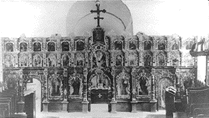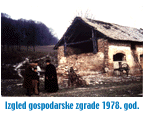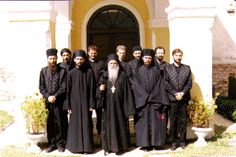
The Monastery of Lepavina
(brief historical review)
According to an ancient Lepavina chronologist, the monastery of Lepavina was founded around the year of 1550, shortly after the first Serbian settlements had been established in this region. The almanac asserts that it was established by Jefrem Vukobratovic, a monk of Hilandar monastery originally from Herzegovina who came in concealment to the region looking for a shelter from the Turkish invasion. Having heard about him, two other monks came from Bosnia to join him. Learning that the land was very fertile, they invited people from Bosnia and the valley was soon filled with newcomers. It was then that a necessity to build a monastery to satisfy people's religious needs occurred.
Having learned about the intention, the Turks from Stupcanica, Pakrac and Bijela, led by Zarep-Aga Alija attacked the monastery in August 1557, burned it down, killed four monks and captured two in slavery. However, the idea of having a monastery as a spiritual center for the new settled Serbs was not abandoned. In 1598, Protomonk Grigorije of Hilandar, accompanied by two brothers of Milesevo monastery arrived and began to reconstruct the monastery together with the villagers. Due to uncertain times and modest means, the process of the reconstruction was rather slow. Proper conditions for the construction of the monastery were set up only in 1630 when the Serbs became an important factor in the defense of the internal Austrian countries by obtaining privileges and upon the arrival of Archmandrite Visarion in 1635. The Serbs started basic construction of the monastery Lepavina in 1636 under Archmandrite Visarion's supervision and despite all the difficulties the construction was finished in 1642.
In September 1642, Baron Ivan Galer confirmed the monastery's right to all the land that the villagers of Branjska and Sesvecani donated to the monastery. The approval came in special letters also from Baron Sigmund Ajbeslavd, Count Gvozden and Djordje Dobrojevic, Blaz Pejasinovic and Count Radovan (5 February 1644), Baron Honoree Trautsmandorf (10 July 1644) and Djordje Ljudevit Svarcernberg (23 November 1644). The life was finally ensured for the monastery. After that, its religious, patriotic and cultural-historical life began to flourish in all its fullness.
The history of Lepavina monastery is inseparably linked with the history of the Serbs in Varazdin Generality. From the time of its reconstruction and on, a severe and permanent struggle to convert Serbs into Uniate or Catholic Church was on. The struggle was also aimed at enslaving of the Krainian Serbs. Defending their faith and people's privileges (Valoharum Statute) Lepavina monks have always been on their own people's side, fighting and suffering together.
In 1666, they joined and suffered in a big Osmoruhovic's
riot. In 1672 together with Gomir monks (all 14, none left) were caught,
put in chains and shipped to Malta for life sentence. On 26/13  November
1735, the Prior Kodrat was shot dead on the doorstep of the monastery church.
Patriarch Arsenije III Carnojevic spent some time in Lepavina by the end
of 1692 and the beginning of 1693 - a spiritual center of Varazdin Generality
Serbs. The Patriarch would gather people and priests there and go to visit
nearby Kraininan Counts in their homes. The Patriarch's visit improved already
existing reputation of the monastery, which was of a particular importance
at that time when Unates were introduced in Marca. People's deputies often
met in Lepavina with their patriotic monks concerned about people's troubles
trying to find a way out of grave situations. For that reason, when the
Serbs from Varazdin Generality succeeded to get their own Orthodox Episcope
in 1734, apart from the Uniatic one, sitting in Marca without parishians,
Lepavina was chosen as a residence of the new Episcope. Due to its geographic
position [in the outskirts of the Episcopate and the Serb villages] it was
ultimately decided that the residence of the Episcope should be in Severin.
Yet, the new Eparchy was named "Lepavina-Severin" due to Lepavina's
great importance. The first Lepavina-Severin Episcope Simeon (Filipovic)
who died in Koprivnica investigative prison was buried in Lepavina monastery.
November
1735, the Prior Kodrat was shot dead on the doorstep of the monastery church.
Patriarch Arsenije III Carnojevic spent some time in Lepavina by the end
of 1692 and the beginning of 1693 - a spiritual center of Varazdin Generality
Serbs. The Patriarch would gather people and priests there and go to visit
nearby Kraininan Counts in their homes. The Patriarch's visit improved already
existing reputation of the monastery, which was of a particular importance
at that time when Unates were introduced in Marca. People's deputies often
met in Lepavina with their patriotic monks concerned about people's troubles
trying to find a way out of grave situations. For that reason, when the
Serbs from Varazdin Generality succeeded to get their own Orthodox Episcope
in 1734, apart from the Uniatic one, sitting in Marca without parishians,
Lepavina was chosen as a residence of the new Episcope. Due to its geographic
position [in the outskirts of the Episcopate and the Serb villages] it was
ultimately decided that the residence of the Episcope should be in Severin.
Yet, the new Eparchy was named "Lepavina-Severin" due to Lepavina's
great importance. The first Lepavina-Severin Episcope Simeon (Filipovic)
who died in Koprivnica investigative prison was buried in Lepavina monastery.
 Today's monastery church was built in mid 18th century.
The initiator was a former "protopop horvacki" and the parish
of Pisanica Nikola Popovic, famous for founding a big and beautiful Pisanica
church. As the then Lepavina Archmandrite Nikofor he was in charge of the
construction of today's church. The finished church was blessed by Kostajnica-Zrinopolje
Episcope Arsenije (Teofanovic) [who spent most of his time in Severin] on
25 March 1753. The church has baroque features outside, but the interior
preserved many elements of the old Serbian-Bizantine style. It was renovated
and decorated afterwards.
Today's monastery church was built in mid 18th century.
The initiator was a former "protopop horvacki" and the parish
of Pisanica Nikola Popovic, famous for founding a big and beautiful Pisanica
church. As the then Lepavina Archmandrite Nikofor he was in charge of the
construction of today's church. The finished church was blessed by Kostajnica-Zrinopolje
Episcope Arsenije (Teofanovic) [who spent most of his time in Severin] on
25 March 1753. The church has baroque features outside, but the interior
preserved many elements of the old Serbian-Bizantine style. It was renovated
and decorated afterwards.
For the history of Lepavina monastery, inseparably linked is the icon of the Holy Mother of Lepavina. It dates from the beginning of the 16th century and is the work of an unknown author. The icon is reasonably believed to have miraculous healing powers.
 The monastery church got a special value in
1775 when Jovan Catirevic-Grabovac, known as one of the best painters of
Serb early baroque was making there an artistic iconostasis. The work was
financed mainly by Fieldmarshallieutenant Mihail Mikasinovic joined by the
other sponsors. To commemorate it, his coat of arms was carved under the
icon of St. John with the inscription: "Mihal Mikasinovic Mr. Fieldm.
Lieut." That was one of the best Grabovanov's iconostasis.
The monastery church got a special value in
1775 when Jovan Catirevic-Grabovac, known as one of the best painters of
Serb early baroque was making there an artistic iconostasis. The work was
financed mainly by Fieldmarshallieutenant Mihail Mikasinovic joined by the
other sponsors. To commemorate it, his coat of arms was carved under the
icon of St. John with the inscription: "Mihal Mikasinovic Mr. Fieldm.
Lieut." That was one of the best Grabovanov's iconostasis.
Unfortunately, the iconostasis was destroyed during the
WW II. Only three icons are preserved, the two of which are badly  damaged. Yet, they witness about high artistic values of this iconostasis.
Some icons date from earlier periods, such as the icon of St. Simeon Nemanja,
St. Sava and the icon of Assumption of Holy Mother of God created in Lepavina
in 1647.
damaged. Yet, they witness about high artistic values of this iconostasis.
Some icons date from earlier periods, such as the icon of St. Simeon Nemanja,
St. Sava and the icon of Assumption of Holy Mother of God created in Lepavina
in 1647.
Besides iconographic monuments, particularly valuable are ancient handwritten and printed books. The two-quatrain Holy Scripts dating from 13th and 14th century are among the oldest ones. One Script is of Serb-Raska while another one is of Macedonian redaction. Both contain beautiful initials.
Lepavina is not only a guardian of delivered books and items. It is proud of being the place where books were written, re-written and reproduced. It could not have been different because the monastery was obliged to satisfy cultural needs of the Serb population there. The school was also located in the monastery. Not only monastery youth was educated there but priest-youth in general as well as the young men who after having acquired basic literacy and knowledge would enter military service or would continue to study in Vienna, Pozun or elsewhere.
All this has extremely raised the reputation of Lepavina monastery and inspired people to come in endless lines for great holidays and particularly for temple celebrations to pray to God and replenish soles with God's mercy that would give them strength to carry on.
The role of this monastery has been of utmost importance throughout centuries. It always shared the grave fate with its people and suffered repeatedly.
The hardest blow came during the II World War. Right after
the occupation the fraternity was arrested and taken to a concentration
camp. Protodeacon Joakim (Babic) was killed and the other 
 monks were expelled to Serbia. On 27 October 1943, the Germans ordered
bombardment of the monastery. The monastery buildings were almost totally
destroyed and the church and konak were heavily damaged. The iconostasis
and furniture were demolished and burned.
monks were expelled to Serbia. On 27 October 1943, the Germans ordered
bombardment of the monastery. The monastery buildings were almost totally
destroyed and the church and konak were heavily damaged. The iconostasis
and furniture were demolished and burned.  Only a part of the monastery
library was preserved in the remaining wing of monastery konak.
Only a part of the monastery
library was preserved in the remaining wing of monastery konak.
Owing to His Illustrious Highness Jovan (Pavlovic) who
arrived in Zagreb-Ljubljana Eparchy in 1978, the  Lepavina monastery
started to gradually redeem its previous glow and significance. His Illustrious
Highness to whom this shrine was particularly dear did not regret spare
effort or time to recover true monastery life in it. The connection with
Hilandar
Lepavina monastery
started to gradually redeem its previous glow and significance. His Illustrious
Highness to whom this shrine was particularly dear did not regret spare
effort or time to recover true monastery life in it. The connection with
Hilandar monastery was revived in 1984 with the arrival of father
Gavrilo (Vuckovic) of Hilandar. Thus, the striving and effort of Mitropolitan
Jovan was multiplied.
monastery was revived in 1984 with the arrival of father
Gavrilo (Vuckovic) of Hilandar. Thus, the striving and effort of Mitropolitan
Jovan was multiplied.
The World Council of Churches, Evangelistic youth branch
from  Wurttenberg and the Evangelistic church from Stuttgardt headed by the
nun Ursula are also expressing a wish to participate in the reconstruction
of the monastery. His Illustrious Highness absolutely facilitates their
strivings. However, the war that broke out in 1991 prevented the finalization
of the reconstruction and postponed it for some better times.
Wurttenberg and the Evangelistic church from Stuttgardt headed by the
nun Ursula are also expressing a wish to participate in the reconstruction
of the monastery. His Illustrious Highness absolutely facilitates their
strivings. However, the war that broke out in 1991 prevented the finalization
of the reconstruction and postponed it for some better times.
 Contemporary spiritual life of the Lepavina monastery
is rising again thanks to self-sacrificing work of the Prior Archmadrite
father Gavrilo (Vuckovic). The five-member brotherhood together
Contemporary spiritual life of the Lepavina monastery
is rising again thanks to self-sacrificing work of the Prior Archmadrite
father Gavrilo (Vuckovic). The five-member brotherhood together with the Prior by publishing a monastery magazine Put, Istina i Zivot
(Path, Truth and Life) once in two months is trying to regain faith in the
soles of its parishians and all those searching for a true spiritual life.
with the Prior by publishing a monastery magazine Put, Istina i Zivot
(Path, Truth and Life) once in two months is trying to regain faith in the
soles of its parishians and all those searching for a true spiritual life.
On St. Spiridon Miraculous Day 1998
In Lepavina monastery
Prepared by:
Monk Vasilije (Srbljan)
according to the publication
"The Serb Monasteries
in Croatia and Slavonia"
by Dr. Dusan Kasic
Assisted by:
Prof. Nada Bekic
Translated by:
Prof. Ruzica Vidakovic